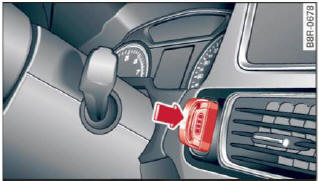Audi Q5: Ignition lock
Starting engine with the key
The ignition is switched on and the engine started with the ignition key.

Fig. 99 Ignition key
Starting the engine
- Insert the key into the ignition lock.
- Hybrid drive: refer to the information for starting the vehicle under.
- Step on the brake pedal and move the selector lever to the P or N position.
- Press the key > fig. 99 - the engine will start.
- It is possible that there will be a slight delay
when starting the engine for diesel vehicles in
colder temperatures. Therefore, you must hold
the brake pedal down until the engine starts.
The indicator lamp
.png) illuminates
when the engine
is preheated.
illuminates
when the engine
is preheated.
Switching the ignition on/off
If you would like to switch the ignition on without starting the engine, follow these steps:
- Insert the key into the ignition lock.
- Press the key briefly without press the brake pedal.
- To switch the ignition off, press the key again.
Diesel vehicles are preheated while the ignition is switched on.
When starting the engine, major electrical loads are switched off temporarily.
You can only remove the key with the ignition switched off. To do this, you have to press on the key again.
If the engine should not start immediately, the starting process is automatically stopped after a short time. Repeat starting procedure.
WARNING
- Never allow the engine to run in confined spaces - danger of asphyxiation.
- Never remove the ignition key from the ignition lock while the vehicle is moving. Otherwise, the steering lock could suddenly engage and you would not be able to steer the vehicle.
- Always take the key with you whenever you
leave your vehicle. Otherwise, the engine
could be started or electrical equipment
such as the power windows could be operated.
This can lead to serious injury.
- Never leave children or persons requiring assistance unattended in the vehicle. The doors can be locked using the remote transmitter, preventing people from escaping from the vehicle on their own in the event of an emergency. Depending on the time of year, people inside the vehicle can be exposed to very high or very low temperatures.
Note
Avoid high engine rpm, full throttle and heavy engine loads until the engine has reached operating temperature - otherwise you risk engine damage.
For the sake of the environment
Do not let the engine run while parked to warm up. Begin driving immediately. This reduces unnecessary emissions.
Tips
- If the key cannot be removed from the ignition lock, you have to pull the mechanical key out of the master key in order to be able to lock the vehicle.
- After starting a cold engine, there may be a brief period of increased noise because the oil pressure must first build up in the hydraulic valve adjusters. This is normal and not a cause for concern.
- If you leave the vehicle with the ignition switched on, the ignition will switch off after a certain period of time. Please note that electrical equipment such as exterior lights will switch off as well when that happens.

